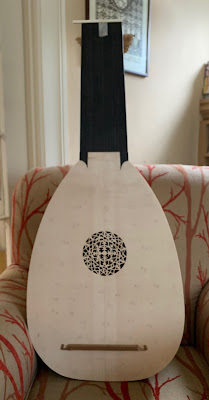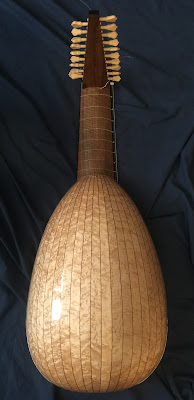When I took this photo three weeks ago my French baroque lute was assembled but there was still much to do. You may be able to see the scribbles on the top. These are thickness measures I made at various locations before I glued the top in place. The idea is to string and tune the instrument and see how it responds. If I think it can be improved by thinning the top in specific spots I scrape some wood off. The top thickness at this point of construction varies from 1.75 mm behind the bridge gradually diminishing to 1.5 in the rose area and 1.0 at the rose itself. Then increasing to 1.8 mm at the neck joint. If you are able to decipher my scribbles the numbers are thousandths of an inch.
The lute bowl shape and size is modelled after E.25, an anonymous instrument that is conserved in Musée de la musique, Paris as an archlute. The details of the top; bridge, rose position and rose diameter are borrowed from the Hans Burkholtzer baroque lute, Kunsthistorisches Museum, Vienna.
There is a strong connection between E.25 and the Burkholtzer but rather than repeat myself see my blog from 9/22/22, "An Anonymous Archlute" and from 2/17/16 "Thirteenth Course Baroque Lute After Hans Burkholtzer and Anonymous E.25".
Like the Burkholtzer, the bowl is assembled with twenty-one ribs, my lute with bird's eye maple and Burkholtzer's with ivory ribs. My lute has walnut spacers as I have given up on ebony for everything other than fingerboards. For thin parts like binding and spacers that need to be bent the quality of today's ebony is poor and it breaks easily. The bowl is varnished with a true oil varnish.
This photo offers a narrow view of the chanterelle bracket. Note that the tenth course is fully on the neck while the eleventh is completely of the edge. The fingerboard is flat rather than arched.
If you think the strings look funny you're right. My client who lives in Buffalo NY planned on taking the lute to the LSA Seminar in Cleveland a week ago. I didn't think there was enough time for my string order to clear customs and get to me here in Montréal before the lute was scheduled to be hand-delivered to Buffalo. I had strung the lute with these strings multiple times to learn what characteristics it displayed and whether there were buzzes on the nut and fingerboard or to reveal other problems. I nearly had enough spare strings but I ended up with only single strings for the 3rd through 5th courses. When the lute reached its owner he strung it with the new and complete set of strings and happily attended the LSA Seminar.
The rose design is from an Unverdorben lute in the collection of Harvard University (see the original below). I am not aware of it appearing on any other instrument.
I took this photo of the original rose when I examined the lute in 2008.
If you study the design you can find instances where the pattern is interrupted or does not repeat as expected. I copied the design as it appears without improving the Master's work.


.jpeg)



.jpeg)